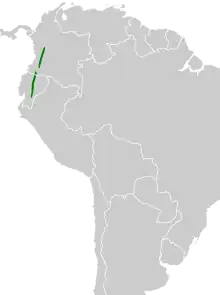Black-backed bush tanager
The black-backed bush tanager (Urothraupis stolzmanni), also known as the black-backed bush-finch, is a species of bird in the family Thraupidae. It is the only member in the genus Urothraupis. It is found in Colombia and Ecuador. Its natural habitat is subtropical or tropical moist montane forests.

| Black-backed bush tanager | |
|---|---|
.jpg.webp) | |
| A Black-backed Bush Tanager in Ecuador on 23 January 2020 | |
| Scientific classification | |
| Domain: | Eukaryota |
| Kingdom: | Animalia |
| Phylum: | Chordata |
| Clade: | Dinosauria |
| Class: | Aves |
| Order: | Passeriformes |
| Family: | Thraupidae |
| Genus: | Urothraupis Taczanowski & Berlepsch, 1885 |
| Species: | U. stolzmanni |
| Binomial name | |
| Urothraupis stolzmanni Taczanowski & Berlepsch, 1885 | |
 | |
Taxonomy
The black-backed bush tanager was formally described in 1885 by Władysław Taczanowski and Hans von Berlepsch from specimens collected by the Polish zoologist Jan Sztolcman (sometimes written Jean Stolzmann) on the eastern slopes of the Tungurahua Volcano in central Ecuador. The ornithologists introduced the monospecific genus Urothraupis and coined the binomial name Urothraupis stolzmanni.[2][3] The genus name combines the Ancient Greek oura meaning "tail" with thraupis, an unidentified small bird, used by ornithologist for tanagers. The specific epithet honors the collector Sztolcman/Stolzmann.[4] A 2014 molecular phylogenetic study of the tanager family Thraupidae found that the black-backed bush tanager is a member of the subfamily Poospizinae and has a sister relationship to the pardusco in the monospecific genus Nephelornis.[5] The black-backed bush tanager is monotypic: no subspecies are recognised.[6]
References
- BirdLife International (2016). "Urothraupis stolzmanni". IUCN Red List of Threatened Species. 2016: e.T22723028A94800182. doi:10.2305/IUCN.UK.2016-3.RLTS.T22723028A94800182.en. Retrieved 12 November 2021.
- Taczanowski, Władysław; Berlepsch, Hans von (1885). "Troisième liste des oiseaux recueillis par M. Stolzmann dans l'Ecuadeur". Proceedings of the Zoological Society of London (in French). 1885: 67–124 [83].
- Paynter, Raymond A. Jr, ed. (1970). Check-List of Birds of the World. Vol. 13. Cambridge, Massachusetts: Museum of Comparative Zoology. p. 208.
- Jobling, James A. (2010). The Helm Dictionary of Scientific Bird Names. London: Christopher Helm. pp. 366, 387. ISBN 978-1-4081-2501-4.
- Burns, K.J.; Shultz, A.J.; Title, P.O.; Mason, N.A.; Barker, F.K.; Klicka, J.; Lanyon, S.M.; Lovette, I.J. (2014). "Phylogenetics and diversification of tanagers (Passeriformes: Thraupidae), the largest radiation of Neotropical songbirds". Molecular Phylogenetics and Evolution. 75: 41–77. doi:10.1016/j.ympev.2014.02.006. PMID 24583021.
- Gill, Frank; Donsker, David; Rasmussen, Pamela, eds. (July 2020). "Tanagers and allies". IOC World Bird List Version 10.2. International Ornithologists' Union. Retrieved 6 November 2020.
